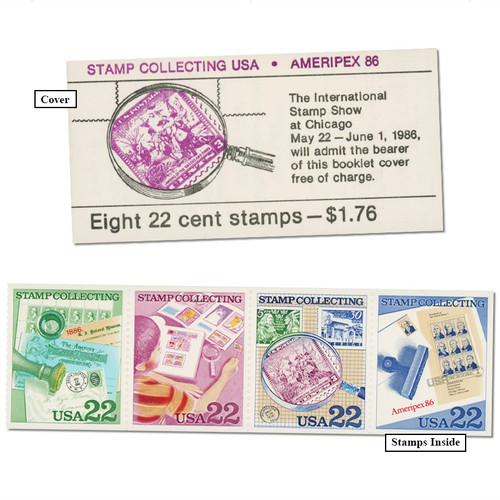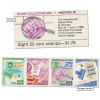
# BK153 - 1986 Stamp Collecting Booklet - AMERIPEX Admission Ticket, 2 se-tens of 4
22¢ Stamp Collecting
City: State College, PA
Quantity: 116,999,200
Printed By: Sterling Sommers for Ashton-Potter (USA) Ltd
Printing Method: Lithographed and engraved
Perforations: 10 vertically
Color: Multicolored
Joint Issue: Sweden #1585-88
First U.S. Commemorative Booklet
On January 23, 1986, the USPS issued its first commemorative booklet, which honored Stamp Collecting.
The booklet was born out friendly relationship between the US and Sweden’s postal departments. In 1938 and 1948 the US had issued stamps with Swedish themes – the tercentenary of the Swedish-Finnish settlement of Wilmington and the 100th anniversary of Swedish pioneers in the American West. Then in 1983, the US and Sweden worked together on a joint issue honoring the 200th anniversary of the Treaty of Amity and Commerce.
The success of that issue led to talks of another joint-issue between the US and Sweden. During those talks, the president of the Swedish Post Office suggested that both countries issue stamps with philatelic subjects. In 1986, the US and Sweden were each going to host international stamp exhibitions (STOCKHOLMIA and AMERIPEX) and both nations were celebrating significant stamp anniversaries that year. For Sweden, 1986 marked the 250th anniversary of their post office and the 100th anniversary of the Swedish Philatelic Society. In America, 1986 was the 100th anniversary of the American Philatelic Society and the centennial of the Smithsonian accepting stamps for the National Collection.
At the same time these talks were going on, US, postal authorities had begun discussing issuing their first commemorative booklet. So both ideas were combined and by November 1984, the US and Sweden began looking into the technical requirements of a joint booklet honoring stamp collecting.
US officials knew printing would be a challenge for this design. For several years, the Bureau of Engraving and Printing (BEP) had been experimenting with the D Press, which combined both intaglio and offset printing. For intaglio printing, an image is etched or engraved on a metal plate, covered with ink and then pressed onto the paper. With offset printing, the image is created on a plate, transferred to a rubber blanket and then printed on paper.
Because the D Press combined these two techniques, many of the early stamps printed on it had colors that were not lined up. However, the printing of the Stamp Collecting pane, America’s first commemorative booklet, was described as “the finest, most complex printing job to come out of the Bureau” in years.
Each booklet included four different designs. In the US booklet, the first stamp pictured a block of 12 green 1887 2¢ Washington stamps with an 1886 cancel. The second stamp showed a young boy with a collection of dog stamps, including several identifiable US stamps such as the 1983 Kitten and Puppy issue and the 1984 American dogs set. The third stamp pictures the 1938 commemorative honoring Swedish and Finnish settlement. The fourth stamp pictures the Presidential sheetlets that would be issued that May – it was the first US stamp to picture a stamp that had not yet been issued.
The first stamp in the Sweden booklet pictures that nation’s “tretio” error, in which the numeral read 20 but the lettering said 30 krona. The second stamp pictures Sven Ewert, who engraved most of Sweden’s stamps between 1928 and the late 1950s. The third stamp is similar (but not identical) to the third stamp in the US issue. And the fourth stamp pictures a young boy soaking stamps for his collection.
On January 23, 1986, the booklets were simultaneously issued in Stockholm, Sweden, and State College, Pennsylvania. US representatives attended the Stockholm ceremony and Swedish representatives participated in the Pennsylvania ceremony. During the ceremonies, one US representative stated, “We have so admired Swedish stamps that we used new equipment, new techniques and new dedication to attempt to give our stamps ‘a Swedish look.’” The US stamp booklets were only available for sale for 60 to 90 days.
22¢ Stamp Collecting
City: State College, PA
Quantity: 116,999,200
Printed By: Sterling Sommers for Ashton-Potter (USA) Ltd
Printing Method: Lithographed and engraved
Perforations: 10 vertically
Color: Multicolored
Joint Issue: Sweden #1585-88
First U.S. Commemorative Booklet
On January 23, 1986, the USPS issued its first commemorative booklet, which honored Stamp Collecting.
The booklet was born out friendly relationship between the US and Sweden’s postal departments. In 1938 and 1948 the US had issued stamps with Swedish themes – the tercentenary of the Swedish-Finnish settlement of Wilmington and the 100th anniversary of Swedish pioneers in the American West. Then in 1983, the US and Sweden worked together on a joint issue honoring the 200th anniversary of the Treaty of Amity and Commerce.
The success of that issue led to talks of another joint-issue between the US and Sweden. During those talks, the president of the Swedish Post Office suggested that both countries issue stamps with philatelic subjects. In 1986, the US and Sweden were each going to host international stamp exhibitions (STOCKHOLMIA and AMERIPEX) and both nations were celebrating significant stamp anniversaries that year. For Sweden, 1986 marked the 250th anniversary of their post office and the 100th anniversary of the Swedish Philatelic Society. In America, 1986 was the 100th anniversary of the American Philatelic Society and the centennial of the Smithsonian accepting stamps for the National Collection.
At the same time these talks were going on, US, postal authorities had begun discussing issuing their first commemorative booklet. So both ideas were combined and by November 1984, the US and Sweden began looking into the technical requirements of a joint booklet honoring stamp collecting.
US officials knew printing would be a challenge for this design. For several years, the Bureau of Engraving and Printing (BEP) had been experimenting with the D Press, which combined both intaglio and offset printing. For intaglio printing, an image is etched or engraved on a metal plate, covered with ink and then pressed onto the paper. With offset printing, the image is created on a plate, transferred to a rubber blanket and then printed on paper.
Because the D Press combined these two techniques, many of the early stamps printed on it had colors that were not lined up. However, the printing of the Stamp Collecting pane, America’s first commemorative booklet, was described as “the finest, most complex printing job to come out of the Bureau” in years.
Each booklet included four different designs. In the US booklet, the first stamp pictured a block of 12 green 1887 2¢ Washington stamps with an 1886 cancel. The second stamp showed a young boy with a collection of dog stamps, including several identifiable US stamps such as the 1983 Kitten and Puppy issue and the 1984 American dogs set. The third stamp pictures the 1938 commemorative honoring Swedish and Finnish settlement. The fourth stamp pictures the Presidential sheetlets that would be issued that May – it was the first US stamp to picture a stamp that had not yet been issued.
The first stamp in the Sweden booklet pictures that nation’s “tretio” error, in which the numeral read 20 but the lettering said 30 krona. The second stamp pictures Sven Ewert, who engraved most of Sweden’s stamps between 1928 and the late 1950s. The third stamp is similar (but not identical) to the third stamp in the US issue. And the fourth stamp pictures a young boy soaking stamps for his collection.
On January 23, 1986, the booklets were simultaneously issued in Stockholm, Sweden, and State College, Pennsylvania. US representatives attended the Stockholm ceremony and Swedish representatives participated in the Pennsylvania ceremony. During the ceremonies, one US representative stated, “We have so admired Swedish stamps that we used new equipment, new techniques and new dedication to attempt to give our stamps ‘a Swedish look.’” The US stamp booklets were only available for sale for 60 to 90 days.







